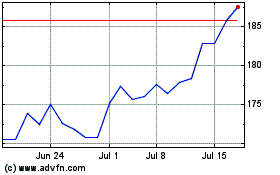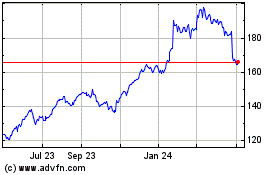By Ted Greenwald
This article is being republished as part of our daily
reproduction of WSJ.com articles that also appeared in the U.S.
print edition of The Wall Street Journal (April 18, 2018).
International Business Machines Corp. posted its second
consecutive quarter of higher revenue after nearly six years of
declines, a sign that Chief Executive Ginni Rometty's slow-moving
turnaround may be taking hold.
Revenue in the quarter rose in all of the company's major
business units. Still, the results underscored the fragility of
IBM's shift from older businesses supplying on-site technology to
faster-growing businesses based on cloud computing.
The quarter's performance was plumped by sales of new hardware
that analysts expect to eventually peter out. Profit margins,
meanwhile, continued to narrow from a year earlier.
Revenue rose 5% to $19.07 billion from a year earlier, its
strongest gain for the top line since the third quarter 2011. As in
the previous quarter, though, adjusting for currency-exchange rates
tells a different story. Stripping out the impact of foreign
exchange, IBM said revenue was flat.
Several quarters ago, the company found itself on the other side
of the issue, where unfavorable rates made IBM's revenue declines
steeper than they appeared when adjusted for currencies.
Profit fell 4% to $1.68 billion. Shares of the tech giant sank
5.7% in after-hours trading, after closing up 1.9% at $160.91. The
stock has lost 6% in the past 12 months, even as the S&P 500
index has risen 15%.
The stock market reacted to overoptimism arising from IBM's
revenue turnaround in the fourth quarter, said Daniel Ives, an
analyst with GBH Insights. "Ultimately you'd call it a good
quarter, but the bulls were looking for more," he said.
Ms. Rometty has been working to turn around IBM almost since the
moment she took over from Sam Palmisano in 2012, as the emerging
industry of cloud computing ate away at IBM's business of managing
information technology in customers' facilities.
She has refashioned IBM as a cloud provider, seeking to
differentiate the company's offerings from lower-cost competitors
through buzzy technologies such as its artificial-intelligence
tools and blockchain, a decentralized way to execute and track
transactions.
IBM expects these offerings, which it calls strategic
imperatives, to grow more rapidly than its legacy businesses are
shrinking, propelling IBM to faster revenue growth as they come to
constitute a bigger portion of overall sales.
The company said strategic-imperatives revenue reached $37.7
billion, making up 47% of its revenue over the past 12 months, and
remains on track to reach $40 billion by the end of the year.
"The overarching message," IBM finance chief James Kavanaugh
said, "is that we grew revenue, stabilized our gross margin across
all our lines of business and grew operating profit, cash, and
earnings per share. So a good start to the year, overall."
However, margins remain an issue. The Systems division, which is
responsible for mainframe computers, and the Cognitive Solutions
division that includes high-profile offerings such as Watson, both
took a hit.
Mr. Kavanaugh attributed the narrowing Cognitive Solutions
margin to investments in developing technologies like artificial
intelligence.
Although IBM has two quarters of growth behind it, its rebound
is still a work in progress. The quarter's results benefited from
sales of a refreshed line of computing hardware that may not
last.
Revenue in the Systems division grew 7.5%, or 4% when adjusted
for currency, reflecting healthy sales of the company's latest
mainframes. IBM introduced new hardware last year, helping revenue
in the Systems division grow by double digits in the second half of
2017.
But several analysts expect the mainframe cycle to tail off by
the end of the year, creating a challenge for IBM to maintain its
momentum, especially since hardware sales tend to also have a
beneficial effect on revenue in other divisions. Toni Sacconaghi,
an analyst at Bernstein Research, estimates that hardware drives
sales of related support services, software, storage and financing
that historically have made up roughly 40% of IBM's operating
profit.
IBM will need to turn around declining revenue in its services
businesses to make up the difference, some analysts said. Those
businesses grew around 4.5% in the quarter, reversing their
declining trajectory in recent quarters. Getting those divisions
growing consistently is essential to IBM's long-term health,
according to some analysts.
The Armonk, N.Y., company reported $2.45 in per-share earnings
on an adjusted basis, which omits such items as acquisition- and
retirement-related charges. Analysts had expected $2.42 a share on
$18.84 billion in revenue, according to a survey by Thomson
Reuters.
Corrections & Amplifications IBM reported a quarterly profit
Tuesday. An earlier version of this article incorrectly stated it
reported a loss, in the headline.
--Maria Armental contributed to this article.
Write to Ted Greenwald at Ted.Greenwald@wsj.com
(END) Dow Jones Newswires
April 18, 2018 02:47 ET (06:47 GMT)
Copyright (c) 2018 Dow Jones & Company, Inc.
International Business M... (NYSE:IBM)
Historical Stock Chart
From Mar 2024 to Apr 2024

International Business M... (NYSE:IBM)
Historical Stock Chart
From Apr 2023 to Apr 2024
